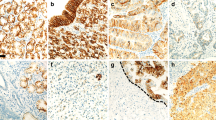Abstract
Background
Reliable method to predict lymph node metastasis is not yet available. In the present study, therefore, we examined LI-cadherin expression in human gastric cancer and attempted to find its relationship with clinicopathologic data, especially with lymph node metastasis. We also analyzed the expression in preoperative biopsy specimen to uncover its possibility of prognostication for lymph node metastasis.
Methods
The paired preoperative endoscopic biopsy and postoperative resected specimens from 208 patients who had surgically been treated for gastric cancer were retrospectively analyzed immunohistochemically for expression of LI-cadherin.
Results
There were 47 (22.6%) and 161 (77.4%) tumors which had positive and negative LI-cadherin expression, respectively. LI-cadherin expression was significantly correlated with tumor histology and lymph node metastasis: Furthermore, reduced expression of LI-cadherin was closely associated with tumor progression and lymph node metastasis in human gastric carcinoma. LI-cadherin expressions in both resected tumor and preoperative endoscopic tissues were found to be independent factors associated with lymph node metastasis.
Conclusions
There is a close association between reduced expression of LI-cadherin and lymph node metastasis in human gastric cancer. Immunohistochemical study of LI-cadherin is relatively simple compared to sentinel node navigation surgery, and it could be a practical prediction method for lymph node metastasis in patients with this malignancy.

Similar content being viewed by others
References
Ohashi S, Segawa K, Okamura S, et al. The utility of endoscopic ultrasonography and endoscopy in the endoscopic mucosal resection of early gastric cancer. Gut 1999; 45:599–604
Matsumoto Y, Yanai H, Tokiyama H, Nishiaki M, Higaki S, Okita K. Endosopic ultrasonography for diagnosis of submucosal invasion in early gastric cancer. J Gastroenterol 2000; 35:326–31
Takeichi M. Cadherin cell adhesion receptors as a morphogenetic regulator. Science 1991; 251:1451–5
Geiger B, Ayalon O. Cadherins. Annu Rev Cell Biol 1992; 8:307–32
Birchmeier W, Behrens J. Cadherin expression in carcinomas: role in the formation of cell junctions and the prevention of invasiveness. Biochem Biophys Acta 1994; 27:11–26
Gessner R, Tauber R. Intestinal cell adhesion molecules. Liver–intestine cadherin. Ann N Y Acad Sci 2000; 915:136–43
Lee HK, Yang HK, Kim WH, Lee KU, Choe KJ, Kim JP. Influence of the number of lymph nodes examined on staging of gastric cancer. Br J Surg 2001; 88:1408–12
Sobin LH, Wittekind Ch, eds. TNM Classifications of Malignant Tumors, 6th edn. New York: Wiley-Liss, 2002.
Japanese Gastric Cancer Association. Japanese classification of gastric carcinoma – 2nd English edn. Gastric Cancer 1998; 1:10–24
Berndorff D, Gessner R, Kreft B, et al. Liver-Intestine cadherin: molecular cloning and characterization of a novel Ca2+-dependent cell adhesion molecule expressed in liver and intestine. J Cell Biol 1994; 125:1353–69
Kreft B, Berndorff D, Bottinger A, et al. LI-cadherin-mediated cell-cell adhesion does not require cytoplasmic interactions. J Cell Biol 1997; 136:1109–21
Schandl L, Ebert MPA, Malfertheiner P. Cadherins and catenins in inflammation and oncogenesis. Digest Liver Dis 2000; 32(suppl 3):S184–7
Grotzinger C, Kneifel J, Patschan D, et al. LI-cadherin: a marker of gastric metaplasia and neoplasia. Gut 2001; 49:73–81
Takamura M, Sakamoto M, Ino Y, et al. Expression of liver–intestine cadherin and its possible interaction with galectin-3 in ductal adenocarcinoma of the pancreas. Cancer Sci 2003; 94:425–30
Hinoi T, Lucas PC, Kuick R, Hanash S, Cho KR, Fearon ER. CDX2 regulates liver–intestine cadherin expression in normal and malignant colon epithelium and intestinal metaplasia. Gastroenterology 2002; 123:1565–77
Takamura M, Ichida T, Matsuda Y, et al. Reduced expression of liver–intestine cadherin is associated with progression and lymph node metastasis of human colorectal carcinoma. Cancer Lett 2004; 212:253–9
Nakajo A, Natsugoe S, Ishigami S, et al. Detection and prediction of micrometastasis in the lymph nodes of patients with pN0 gastric cancer. Ann Surg Oncol 2001; 8:158–62
Cai J, Ikeguchi M, Tsujitani S, Maeta M, Liu J, Kaibara N. Significant correlation between micrometastasis in the lymph nodes and reduced expression of E-cadherin in early gastric cancer. Gastric Cancer 2001; 4:66–74
Tanaka M, Kitajima Y, Edakuni G, Sato S, Miyazaki K. Abnormal expression of E-cadherin and β-catenin may be a molecular marker of submucosal invasion and lymph node metastasis in early gastric cancer. Br J Surg 2002; 89:236–44
Zhou YN, Xu CP, Han B, et al. Expression of E-cadherin and β-catenin in gastric carcinoma and its correlation with the clinicopatholgical features and patient survival. World J Gastroenterol 2002; 8:987–93
Xiangming C, Hokita S, Natsugoe S, et al. Cooccurrence of reduced expression of α-catenin and overexpression of p53 is a predictor of lymph node metastasis in early gastric cancer. Oncology 1999; 57:131–7
Yonemura Y, Endou Y, Kimura K, et al. Inverse expression of S100A4 and E-cadherin is associated with metastatic potential in gastric cancer. Clin Cancer Res 2000; 6:4234–42
Zhang HK, Zhang QM, Zhao TH, Li YY, Yi YF. Expression of mucins and E-cadherin in gastric carcinoma and their clinical significance. World J Gastroenterol 2004; 10:3044–7
Author information
Authors and Affiliations
Corresponding author
Rights and permissions
About this article
Cite this article
Park, SS., Kang, SH., Park, JM. et al. Expression of Liver–Intestine Cadherin and Its Correlation with Lymph Node Metastasis in Gastric Cancer: Can It Predict N Stage Preoperatively?. Ann Surg Oncol 14, 94–99 (2007). https://doi.org/10.1245/s10434-006-9114-9
Received:
Revised:
Accepted:
Published:
Issue Date:
DOI: https://doi.org/10.1245/s10434-006-9114-9




